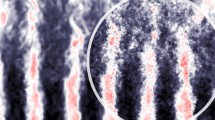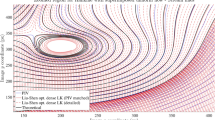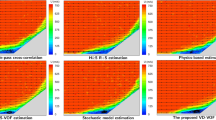Abstract
In biological fluid mechanics powerful imaging methods for flow analysis are required for making progress towards a better understanding of natural phenomena being optimised in the course of evolution. At the same time it is of crucial importance that the measuring and flow visualisation techniques employed guarantee biocompatibility, i.e. they do not distort the behaviour of biosystems. Unfortunately, this restricts seriously the measures for optimising the image generation in comparison to other flow fields in which no biological systems are present. As a consequence, images of lower quality leading to erroneous artefacts are obtained. Thus, either novel detection techniques that are able to overcome these disadvantages or advanced evaluation methods enabling the sophisticated analysis and description of flow fields are essential. In the present contribution, both areas are covered. A novel so-called neuronumerical hybrid allows to detect artefacts in conventional experimental particle image velocimetry (PIV) data of microorganismic flow fields generated by ciliates. The handling of artefacts is performed by the hybrid using a priori knowledge of the flow physics formulated in numerical expressions and the enormous potential of artificial neural networks in predicting artefacts and correcting them. In fact, the neuronumerical hybrid based on the physical knowledge provided by the Taylor’s hypothesis can detect not only spurious velocity vectors but also additional phenomena like a moving boundary, in the present case caused by the contraction of the zooid of a microorganism. Apart from the detection of the artefacts, a correction of the spurious velocity vectors is possible. Furthermore, a method to detect microscopic velocity fields based on nonlinear optical filtering, optical novelty filter (ONF) is presented. On the one hand, it can be employed to expose phase changes in flow fields directly from the nonlinear response and without additional tracers. On the other hand, it can be used to preprocess low quality images of flow fields loaded with particles and extract the motion of particles with an enhanced contrast. The flow fields obtained by the correlation based PIV method of the ONF filtered and unfiltered image sequences are compared and discussed.













Similar content being viewed by others
References
Adrian RJ (1991) Particle-image techniques for experimental fluid mechanics. Ann Rev Fluid Mech 23:261–304
Anderson DZ, Feinberg J (1989) Optical novelty filters. IEEE J Quantum Electron 25:635–647
Anderson DZ, Lininger DM and Feinberg J (1987) Optical tracking novelty filter. Opt Lett 12:123–125
Benning R, Becker T, Delgado A (2001) Initial studies of predicting flow fields with an ANN hybrid. Adv Eng Softw 32:895–901
Blake JR, Otto SR (1996) Ciliary propulsion, chaotic filtration and a blinking stokeslet. J Eng Math 30:151–168
Delgado A, Nirschl H, Becker T (1996) First use of cognitive algorithms in investigations under compensated gravity. Micrograv Sci Technol IX(3):185–192
Díez L, Zima BE, Kowalczyk W, Delgado A (2006) Investigation of multiphase flow in Sequencing Batch Reactor (SBR) by means of hybrid methods. Chem Sci Eng (in press)
Eisenmann H, Letsiou I, Feuchtinger A, Beisker W, Mannweiler E, Hutzler P, Arnz P (2001) Interception of small particles by flocculent structures, sessile ciliates, and the basic layer of a wastewater biofilm. Appl Environ Microbiol 67:4286–4292
Fellner M, Delgado A, Becker T (2003) Functional neurons in dynamical neural networks for bioprocess modelling. Bioprocess Biosyst Eng 25:263–270
Foissner W, Berger H, Kohmann F (1992) Taxonomische und ökologische revision der Ciliaten des Saprobiensystems—band II: Peritrichia, Heterotrichida, Odontostomatida. Informationsberichte des Bayer. Landesamtes für Wasserwirtschaft, Heft 5/92, München
Fried J, Lemmer H, (2003) On the dynamics and function of ciliates in sequencing batch biofilm reactors (SBBR). Water Sci Technol 47: 189–196
van Ginneken V, Antonissen E, Müller UK, Booms R, Eding E, Verreth J, van den Thillart G (2005) Eel migration to the Sargasso: remarkably high swimming efficiency and low energy costs. J Exp Biol 208:1329–1335
Hartmann C, Özmutlu Ö, Petermeier H, Fried J, Delgado A (2006) Analysis of the flow field induced by the sessile peritrichous ciliate Opercularia asymmetrica. J Biomech (in press)
Holtmann F, Krishnamachari VV, Grothe O, Deitmar H, Eversloh M, Wördemann M, Denz C (2006a) Measurement of density changes in fluid flow by an optical nonlinear filtering technique. In: 12th International symposium on flow visualisation (ISFV 2006)
Holtmann F, Wördemann M, Eversloh M, Grothe O, Deitmar H, Krishnamachari VV, Denz C (2006b) Echtzeitbestimmung von Geschwindigkeits- und Dichtefeldern in Mikroströmungen mit Hilfe optisch nichtlinearer. In: Proceedings 14. GALA 2006, Braunschweig 5.-7.9.2006
Krishnamachari VV, Denz C (2003) Real-time phase measurement with a photorefractive novelty filter microscope. J Opt A Pure Appl Opt 5:239–243
Krishnamachari VV, Denz C (2004), A phase-triggering technique to extend the phase-measurement range of a photorefractive novelty filter microscope. Appl Phys B Lasers Opt 79:497–501
Krishnamachari VV, Grothe O, Deitmar H, Denz C (2005) Novelty filtering with a photorefractive lithium–niobate crystal. Appl Phys Lett 87:071105
Liang DF, Jiang CB, Li YL (2003) Cellular neural network to detect spurious vectors in PIV data. Exp Fluids 34:52–62
Orme BA, Blake JR, Otto SR (2003) Modelling the motion of particles around choanoflagellates. J Fluid Mech 475:333–355
Otto SR, Yannacopoulos AN, Blake JR (2001) Transport and mixing in Stokes flow: the effect of chaotic dynamics on the blinking stokeslet. J Fluid Mech 430:1–26
Petermeier H, Delgado A (2006) ANNalyzer basierend auf der Taylor-Hypothese zur Stützung eines Bildauswerteverfahrens für mikroorganismische Strömungen. In: Proceedings 14. GALA 2006, Braunschweig 5.-7.9.2006
Petermeier H, Benning R, Delgado A, Kulozik U, Hinrichs J, Becker T (2002) Hybrid model of the fouling process in tubular heat exchangers for the dairy industry. J Food Eng 55:9–17
Petermeier H, Baars A, Delgado A (2005) "ANNalyzer“—neurohybride Stützung eines Bildauswerteverfahrens, angewendet auf mikroorganismisch generierte Strömungen. In: Proceedings 13. GALA 2005, S. 12.55-1-12.55-6, Cottbus 6.-8.9.2005
Petermeier H, Delgado A, Kondratieva P, Westermann R, Holtmann F, Krishnamachari V, Denz C (2006) Hybrid approach between experiment and evaluation for artefact detection and flow field reconstruction—a novel approach exemplified on microorganismic induced fluid flows. In: 12th International symposium on flow visualization (ISFV 2006) (in press)
Raffel M, Willert Ch E, Kompenhans J (1998) Particle image velocimetry. A practical guide. Springer, Berlin
Rojas R (1996) Neural networks—a systematic introduction. Springer, Berlin
Sedlatschek M, Trumpfheller J, Hartmann J, Müller M, Denz C, Tschudi T (1999) Differentiation and subtraction of amplitude and phase images using a photorefractive novelty filter. Appl Phys B Lasers Opt 68:1047–1054
Sleigh MA, Barlow D (1976) Collection of food by vorticella. Trans Am Micros Soc 95:482–486
Taylor GI (1938) The spectrum of turbulence. Proc R Soc Lond A 164:476–490
Acknowledgments
This study was supported by the German Research Foundation (DFG), projects DE 643/10-1, DE 643/10-2 and DE 486/14-2.
Author information
Authors and Affiliations
Corresponding author
Rights and permissions
About this article
Cite this article
Petermeier, H., Kowalczyk, W., Delgado, A. et al. Detection of microorganismic flows by linear and nonlinear optical methods and automatic correction of erroneous images artefacts and moving boundaries in image generating methods by a neuronumerical hybrid implementing the Taylor’s hypothesis as a priori knowledge. Exp Fluids 42, 611–623 (2007). https://doi.org/10.1007/s00348-007-0269-3
Received:
Revised:
Accepted:
Published:
Issue Date:
DOI: https://doi.org/10.1007/s00348-007-0269-3




